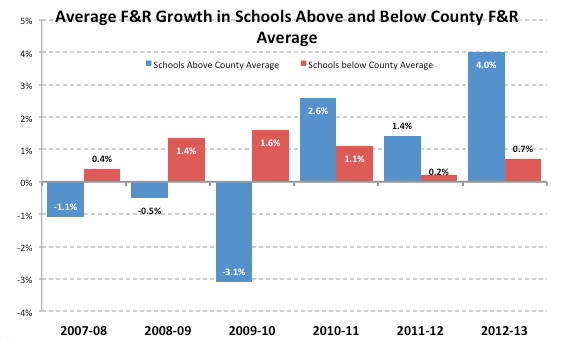Creators of the controlled-choice assignment plan maintained that poverty levels across the county would remain stable under the new plan.
But a Record analysis of new free-and-reduced lunch data shows the poorest schools are getting poorer at a much greater rate than more affluent schools.
We divided Wake’s schools into four equally sized groups. We made a note of which group has the highest percentages of students receiving free-and-reduced lunch and the group with the lowest F&R percentages.
We then averaged the rate of change in each of the four groups.
Schools in the highest quarter added more than 4.5 percent to their F&R numbers, while schools in the lowest quarter added a little more than 1 percent.

The numbers chart a shift between this school year (2011-12) and next (2012-13) based on the results of the recently implemented controlled-choice assignment plan.
In addition, our analysis measured F&R changes between each school year for the past six years.
In the three years before the diversity policy was scrapped in March 2010, schools were actually moving toward the county average, rather than away from it.
The trend reversed the year after the assignment policy was changed, by a Republican majority, to reflect proximity as the most important factor in a student’s school assignment.

Blue bars represent schools where the average F&R growth in schools is above the county average for that year. Red bars represent those below that year’s county average.
Before a proximity policy was put into place, schools above the county average experienced negative growth and vice-versa. In the years since, poorer schools have been adding F&R students at a higher rate than schools below the county average.
Republican board member John Tedesco told the Record the shift shouldn’t be attributed to the policy change. He said Republicans at the time were working off a three-year plan implemented by Democrats.
That’s true. However, the Republican majority did shift groups of students around, after it changed the assignment policy, to get them going to school closer to their homes, despite the three-year plan.
The former diversity policy set a 40 precent cap on the percentage of free-and-reduced students that could attend any particular school. However, many schools exceeded the cap as growth in the county exploded over the past decade.
The former policy was based on research that shows schools with higher percentages of F&R students face more challenges. The controlled-choice assignment plan itself reaffirms this research.
In the lead up to the policy change, diversity advocates argued that ending the policy would create high-poverty schools and lead to a system of haves and have-nots.
Proximity advocates argued that neighborhood schools would give communities more ownership and empowerment, as well as end long bus rides. But they also acknowledged that a neighborhood schools plan would lead to higher concentrations of poverty in some schools.
However, the choice plan creators, under the direction of Superintendent Tony Tata, claimed the new controlled-choice plan would lead to F&R percentages staying the same.
“First of all, it’s expected,” said Tedesco, who voted for the choice assignment plan. “When you’re in a recession, you’re going to get increased F&R in sections [of the county] that traditionally struggle economically.”
Tedesco continued, “I think the new model is going to allow us to stabilize it more over time. You can’t look at a snapshot of change.”
But Democratic Board Chair Kevin Hill finds the shift worrisome.
“I can’t speak for the board as to what we will do if anything for August,” Hill said. “But I feel certain that having this information will be important as we look at what to do with assignment for 2013-14 and beyond.”
Hill also said getting this year’s achievement data, once it is available, will be the other critical factor in enabling he and his colleagues to best understand how to guide the new choice plan.
You can email Will Huntsberry at wehberry@raleighpublicrecord.org or find him on twitter @willhuntsberry or #wakeschoolboard
